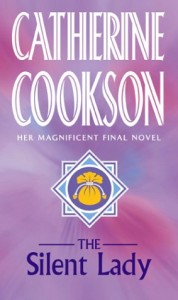“We are in Catherine Cookson country,” our tour guide, Andrew, informed us, as we travelled through north east England. Even though I had heard of this well known British author, I had yet to read her books. However, since then, a good friend, who is an avid Cookson fan, has loaned me her favourites, and I have grown to understand why this writer is so loved and widely read.
Catherine (Davies) Cookson was born in June 1906 in Tyne Dock. She had an alcoholic mother and was raised by her grandparents. Her first novel, Kate Hannigan, is autobiographical in nature and gives a strong sense of the misery and poverty she observed in her youth. Catherine married a teacher, Tom Cookson, who taught in Hastings. A serious depression set in, after she suffered four miscarriages. Catherine turned to writing and published close to 100 books. She died in June 1998 and her husband shortly after. Her books have enjoyed a great deal of popularity, not only in England, but in many other places around the world.
One of Catherine’s trademarks is that she was not afraid to address difficult and sensitive issues of morality and hardship. Her books deal with poverty, homelessness, illegitimacy, abuse, class distinctions and incest. She incorporates these themes into her stories in such a way that the reader becomes intimately involved with the characters and understands their struggles to survive and overcome.
 My favourite Cookson novel is The Silent Lady. What is especially intriguing is the manner in which the story was conceived. Cookson explains in the dedication that she is old and ill, her husband is looking after her many needs, and “[d]octors are forever coming and going.” The last thing she feels equipped to do is write another novel. However, the story of The Silent Lady springs to life of its own accord. She writes: “My mind gave me every character, every incident from the beginning to the end….” Finally, she decides to record the story onto tape and send it to a typist. Within a very short time, her final novel is complete.
My favourite Cookson novel is The Silent Lady. What is especially intriguing is the manner in which the story was conceived. Cookson explains in the dedication that she is old and ill, her husband is looking after her many needs, and “[d]octors are forever coming and going.” The last thing she feels equipped to do is write another novel. However, the story of The Silent Lady springs to life of its own accord. She writes: “My mind gave me every character, every incident from the beginning to the end….” Finally, she decides to record the story onto tape and send it to a typist. Within a very short time, her final novel is complete.
In The Silent Lady, the lovely, young heroine, Irene, pursues a career in singing and acting. She is noticed by a widower, Edward Baindoor, who is desperate for a male heir. They marry and have a son. Edward becomes possessive of the child and abusive towards his wife. A crisis occurs and Edward becomes so enraged that Irene is hospitalized and later, through a series of events, becomes homeless. Irene is taken in by a kind hearted and unforgettable character named Bella. Cookson says, “…when I came to Bella Morgan, I was in her body more than I was in my own.”
One of the consequences of the abuse Irene suffered from her husband, is that she is almost incapable of speech. Thus, she is the “silent lady.” Catherine Cookson used her words prolifically to describe and explain not only her own suffering, but the suffering of her many fictional characters. Now she was at a point in her life where she could not write and her voice was failing her. Taping her novel was an arduous task. Catherine knew that she would very soon be a “silent lady.” The love, pain, self-sacrifice and eventual joy in this novel may well represent Cookson’s own final victory, her last brilliant effort to use her words to inspire and entertain, before she herself fell silent.
Cookson’s novels are readily available in libraries and bookstores, or, if you are fortunate, you may have a friend willing to loan them to you! Now that I have experienced these books for myself, I hope to have another chance to travel through Catherine Cookson country!
If you have read any of Cookson’s novels, which is your favourite?
Happy Reading!
Please Note: Books reviewed on my site are either from my own collection or borrowed and are not reviewed for any kind of monetary gain.